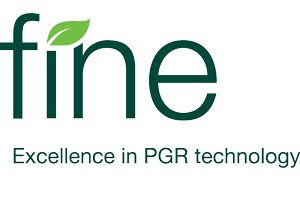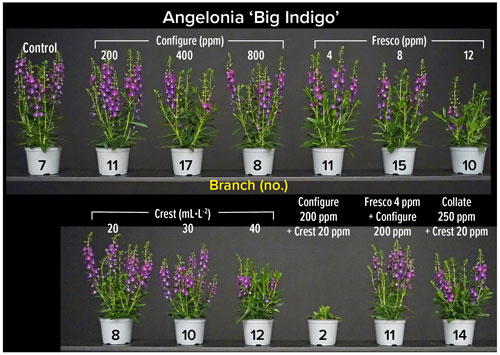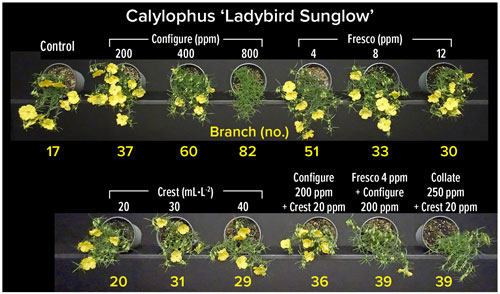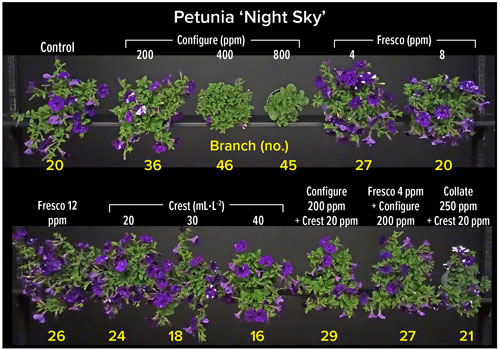7/1/2024
Branching Out with PGRs
Roberto Lopez

Did you know that plant growth regulators (PGRs) have many applications, including suppressing or promoting stem elongation, preventing lower leaf yellowing, increasing branching and rooting, promoting or inhibiting flowering? Most plant growth retardants that inhibit the synthesis of plant hormones (i.e., Gibberellins [GA]) are PGRs used to suppress extension growth (i.e., plant height) of crops to keep them compact. Plant growth retardants with active ingredients of ancymidol (Abide or A-Rest), chlormequat chloride (Altercel or Citadel), daminozide (B-Nine or Dazide), flurprimidol (Topflor), paclobutrozol (Bonzi, Piccolo, Piccolo 10XC, Pac O or Downsize), or uniconazole (Sumagic or Concise) are all GA inhibitors.
However, PGRs that commonly contain synthetic plant hormones that promote lateral branching, rooting, promote or inhibit flowering, or inhibit leaf yellowing are called plant growth regulators. PGRs that enhance branching (branching agents) include active ingredients such as ethephon (Collate 2L and Florel), benzyladenine (BA; Configure) or dikegulac sodium (Atrimmec).
How do these branching PGRs work? Most branching agents promote lateral branching by releasing/interrupting apical dominance and therefore cause lateral axillary buds to break.
How each product works
Plants produce the hormone cytokinin to regulate growth, cell division and even leaf senescence. Synthetic cytokinins such as benzyladenine (BA), thidiazuron and kinetin have been developed for plant applications. The PGR Configure contains 2.0% 6-benzylaminopurine (6-BA) alone and is used to increase lateral branching and promote flowering in certain ornamental species. Additionally, on some crops Configure can reduce stem elongation and result in more compact and well-branched plants. Whereas the PGRs Fascination and Fresco contain 1.8% 6-BA and 1.8% gibberellins A4 and A7 (GA4+7). These BA + GA4+7 products are commonly used to prevent lower leaf yellowing on Easter, LA Hybrid and Oriental lilies and geranium cuttings, and to promote poinsettia bract expansion and stem elongation when plants receive an excessive amount of PGR (i.e., plant growth retardant). Additionally, the combination of both hormones provides synergistic and controlled growth by stimulating internode elongation and axillary shoot growth.
 Figure 1. Growth and flowering responses of Angelonia Big Indigo sprayed with different PGRs two weeks after transplant.
Figure 1. Growth and flowering responses of Angelonia Big Indigo sprayed with different PGRs two weeks after transplant.
Fresco can be applied via foliar spray, media drench or chemigation, while Fascination is only labelled for spray applications. As a gaseous plant hormone, ethylene is known for its role in senescence and fruit ripening. The PGR Collate 2L contains 21.7% and Florel contains 3.9% ethephon [(2-chloroethyl) phosphonic acid]. As a liquid, ethephon breaks down to release ethylene as a gas. Both products are used to inhibit internode elongation, hinder apical dominance, and thus increase lateral branching and abort flower buds and flowers. Currently, both products are only labelled for spray applications. Pending regulatory approval, Collate 2L could be labelled for drench application in 2024.
Lastly, Crest is a product that Fine Americas had on the market until recently. It contained the following 0.010% cytokinin (as Kinetin), 0.005% Indole Butyric Acid (IBA) and 0.005% Gibberellic Acid (GA3). It was labelled for use as a foliar spray or sprench to reduce apical dominance and to promote bud differentiation, cell division, root induction and growth. Configure, Collate, Florel, Fresco and Fascination are labeled for greenhouse use on floriculture crops. Most PGRs have flexible-use options based on their “experimental” use label. This will enable you to legally utilize PGRs on floriculture crops grown in a greenhouse.
 Figure 2. Growth and flowering responses of Calylophus Ladybird Sunglow sprayed with different PGRs two weeks after transplant.
Figure 2. Growth and flowering responses of Calylophus Ladybird Sunglow sprayed with different PGRs two weeks after transplant.
While much research with branching PGRs has focused on perennials, many annuals, including new cultivars and genera, could benefit from PGRs to improve their growth habit and fill in their containers. In this study, we examined the use of branching agent PGRs alone or in combination with other PGRs to see if they synergistically lead to compact and well-branched flowering annuals and perennials and sedges without negatively affecting flowering or causing phytotoxicity.
The study
Rooted liners of Angelonia Big Indigo, Calylophus Ladybird Sunglow, Papyrus King Tut, Lantana Santana Red Orange, Petunia Night Sky, Ivy Geranium Light Lavender, Russian sage Sage Advice, and Verbena rigida Cake Pops were transplanted in 4.5-in., 6-in. or 1-gal. trade pots. After two weeks they received one of the following 13 spray treatments: no spray (control); Configure at 200, 400 or 800 ppm; Fresco at 4, 8 or 12 ppm; Crest at 20, 30 or 40 mg per liter; Configure at 200 ppm + Crest at 20 mL•L-2; Fresco at 4 ppm + Configure at 200 ppm; or Collate at 250 ppm + Crest at 20 mL•L-2. Not surprisingly, the different crops responded differently to the PGRs.
A single spray application of Configure at 400 ppm resulted in angelonia, calylophus, geranium, petunia and Russian sage producing 10, 43, 4, 26 and 82 more branches than the untreated control (Figures 1, 2, and 3). With the exception of Russian sage, all the other crops were much more compact and flowering was delayed compared to the control.
 Figure 3. Growth and flowering responses of Petunia Night Sky sprayed with different PGRs two weeks after transplant.
Figure 3. Growth and flowering responses of Petunia Night Sky sprayed with different PGRs two weeks after transplant.
Generally, 800 ppm of Configure resulted in very-well branched, but stunted plants that flowered two to four weeks later than the control. Angelonia, calylophus, petunia, ivy geranium, verbena and Russia sage treated with Fresco at 4 to 8 ppm produced four to eight, 16 to 34, seven, four to five, six, and nine more branches, respectively, than the control (Figures 1 to 3) .
Overall, the plants’ height was similar to the control and little to no delay in flowering was observed. Crest was effective at rates of 20 to 40 mL•L-2 on angelonia, petunia, Russian sage and papyrus (Figures 1 and 3). A combination of Configure at 200 ppm and Crest at 20 mL•L-2 promoted branching on petunia and ivy geranium (Figure 3). Angelonia, calylophus, petunia and ivy geranium receiving a spray application of Fresco at 4 ppm + Configure at 200 ppm developed four, 22, seven and three more branches than the control (Figures 1, 2 and 3). Flowering of calylophus and ivy geranium was delayed with this combination. Lastly, 250 ppm of Configure + 20 mL•L-2 of Crest resulted increased branching for angelonia, calylophus, cyperus, ivy geranium and Russian sage (Figures 1 and 2).
The collective results of this study indicate that PGRs can be effectively used to increase branching, and in some cases, reduce stem elongation to produce higher-quality crops.
Tips
● 6-BA doesn’t readily move within the plant; therefore, complete coverage is required.
● 6-BA can significantly delay flowering of gaillardia.
● Avoid rates of 10 ppm or higher of BA + GA4+7 products, as it can lead to excessive plant stretch.
● Only apply ethephon when plants are actively growing and not drought or heat stressed.
● The efficacy of ethephon is influenced by the pH of spray solution (ethephon + water) and the air temperature at application. Therefore, ensure the pH of the solution is 4.5 to 5.0 and the temperature at application and 24 hours later is <70F (21C). GT
For more information about PGRs and annual bedding plants, refer to the 2023-24 Plant Growth Regulators Guide for Annuals by Brian Whipker, North Carolina State University. For perennials, refer to the 2024-25 Growth Regulators for Containerized Herbaceous Perennial Plants guide by Garrett Owen, The Ohio State University.
Need help mixing PGRs? The PGRMix Master created by e-GRO (Electronic Grower Resources Online), a collaborative effort of floriculture specialists, and Fine-Americas, Inc. can assist you in mastering all your PGR needs.
Acknowledgements: We thank J.R. Peters for fertilizer, Proven Winners and Mast Young Plants for plant material, East Jordan Plastics for trays, and Fine Americas for financial support.
Roberto Lopez is an Associate Professor and Controlled Environment/Floriculture Extension Specialist.